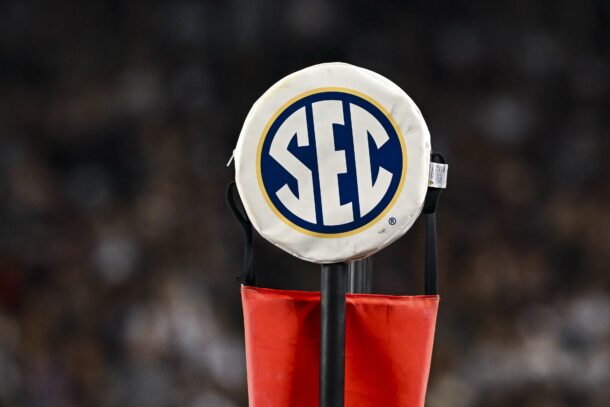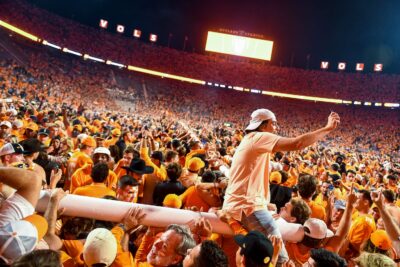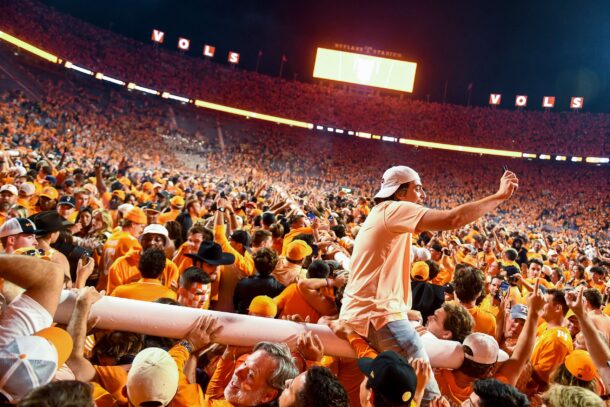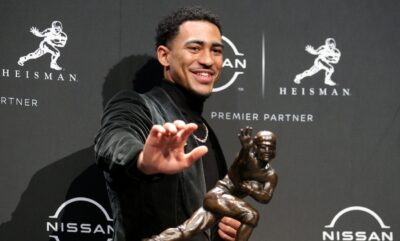
What are the chances Florida’s passing game will be better in 2017?
By Andrew Olson
Published:
GAINESVILLE, Fla. – For Florida, it’s a new year, but the question remains the same: Will the Gators be able to field a formidable passing attack this fall?
Florida averaged a meager 23.9 points in 2016. One reason? The passing game accounted for just 18 touchdowns.
The question has been asked every year since Tim Tebow left town following the 2009 season. From 2010-16, five offensive coordinators have been in change of play-calling at Florida, a seven-year period that covers the final season under Urban Meyer, the Will Muschamp era and head coach Jim McElwain’s first two years. The revolving door period at coordinator has coincided with ups and downs at quarterback.
There’s cautious optimism, however, that things might finally change in 2017.
On paper, this is the year things should come together, finally. McElwain and offensive coordinator Doug Nussmeier are entering their third season at Florida, giving the offense some stability. The majority of the starting 11 on offense will be players recruited by McElwain. At wide receiver, there is an array of talented pass-catchers.
The question, again, is if there’s a quarterback capable of getting them the ball.
Passing yards per game (SEC rank): 215.8 (6)
TDs: 18(8)
INT: 15 (13)
The QB competition
Technically, Luke Del Rio is the incumbent starter. He’s been sidelined, however, since suffering a shoulder injury in Florida’s Week 10 loss at Arkansas. The journeyman graduated from high school in 2013, but the two-time transfer is only a redshirt junior in the eyes of NCAA. Del Rio played in six games last season, and was only truly effective in one, the Gators’ Week 2 thumping of Kentucky 45-7 (19-of-32 passing, 320 yards, 4 TD, INT). On the whole, Del Rio posted a mediocre stat line of 114-of-201, 1,358 yards, eight touchdowns and eight interceptions.
Florida hasn’t thrown more than 20 touchdown passes in a season since Tim Tebow left in 2009.
With Del Rio recovering this spring, redshirt freshmen Feleipe Franks and Kyle Trask battled for the starting job. Franks, a former 4-star recruit ranked the No. 5 pro-style prospect, distanced himself from Trask as practices started to wind down in April and had the more impressive spring game outing (albeit against the second-team defense).
The Crawfordville, Fla., product has the big arm coaches look for in a pocket passer, but has had some issues with accuracy. At the end of spring, Franks had established himself as the clubhouse leader to earn the starting job in Week 1 against Michigan.
The quarterback competition, however, has a late entrant in former Notre Dame QB Malik Zaire, who has announced plans to transfer to Florida. Zaire saw limited playing time in three years with the Irish, but dazzled in the 2014 Music City Bowl against LSU and the 2015 season opener against Texas. He missed the rest of the 2015 season due to injury and lost his starting job to DeShone Kizer.
In three years at Notre Dame, Zaire threw only 98 passes (58-of-98, 816 yards, 6 TD). In his highlights, Zaire has shown the ability to use his mobility to move the pocket and keep a play alive while finding an open receiver. McElwain certainly thinks he can make Zaire’s dual-threat skill set work in a pro-style offense. The big question will be how fast Zaire can learn the playbook, coming in only three months before the first game.
The Gators have two other scholarship quarterbacks on roster, Kadarius Toney and Jake Allen, but they are unlikely to factor into the passing game this fall. Toney looks to be a Wildcat quarterback (if he stays at the position now that Zaire has arrived). Allen will likely redshirt and wait to start his four-year clock.
Receivers/tight ends/RBs
When it comes to pass-catchers, it’s good news and bad news. The good news is that the Gators return their leading wideout, Antonio Callaway (54 catches, 721 yards, 3 TD). The bad news, however, is that with his recent citation for marijuana possession, it’s unclear when Callaway will be able to suit up this fall.

Beyond Callaway, UF has a wide range of weapons at wide receiver, arguably its biggest area of strength on offense. The No. 2 wideout of the 2016 class, Tyrie Cleveland, should be an ideal complement to Callaway and draw his share of coverage in his second season. Senior Brandon Powell and junior college transfer Dre Massey give the Gators a pair of dangerous speedsters to use in the slot. Former 4-star recruits Freddie Swain and Joshua Hammond are in line for more opportunities as sophomores. McElwain added another pair of 4-star wideouts in the most recent recruiting class, Daquon Green and James Robinson.
When it came to receiving yards, tight ends DeAndre Goolsby (38 catches, 342 yards, 3 TD) and C’yontai Lewis (18 catches, 184 yards, 2 TD) checked in at Nos. 3 and 5 on the team, respectively. While they’re not necessarily asked to carry the offense, Goolsby and Lewis will play key roles in the passing attack. Early enrollee Kemore Gamble also impressed this spring at tight end and is expected to see his share of snaps this fall.
After the transfer of Jordan Cronkrite, it appears Mark Thompson will be the running back to contribute to the offense as a pass-catcher. Thompson had one of the biggest plays of the Outback Bowl, an 85-yard touchdown on a screen pass.
Play-calling
Nussmeier spread out passing plays pretty evenly among first (169), second (121) and third (105) downs in 2016, slightly favoring the earlier downs. First down passes were the most eventful, for better or worse.
The Gators threw 11 of their 18 touchdown passes on first down, but also seven of their 15 interceptions. On first down, Florida passers posted a 57.4 completion percentage, not as good as second down (66.9), but better than third down (54.8).
The Gators’ biggest passing play of the year, a 98-yard touchdown pass from Austin Appleby to Cleveland (pictured), came on first down. Overall, UF gained 1,356 passing yards, close to half the team’s total of 2,805 yards, on first down.

It’s interesting that first down had the most of the best possible (touchdown) and worst possible outcome (interception). It’s not surprising that the lowest completion percentage came on third down, a traditional passing down. Despite having the lowest completion percentage, third down passes led to the most first downs (44).
One stat that must improve
When the Gators face 3rd-and-long, they need to focus on actually getting past the first-down marker. The stat breakdown for the situation is interesting.
When facing third down with 10-plus yards to go, the Gators had a 71.4 completion percentage (15-of-21). Those 15 completions, however, resulted in only seven first downs. That means that on at least eight attempts, Florida quarterbacks were throwing to receivers who were under the first down line.
This is either poor decision-making by the quarterbacks, bad play-calling or poor route-running — or all three.
Greatest concern
Put simply, the greatest concern is more of the same. After years of watching inconsistent quarterback play, it’s hard for Gator Nation to ever get optimistic.
There is cautious optimism surrounding Franks. He was a highly sought after recruit, and he has the height and the arm strength one looks for at the position. Franks was the better of the two redshirt freshmen quarterbacks in the spring game, but he was far from perfect. He was only 8-of-14 on his passes, and this was against the second-team pass-rush and secondary. A year ago, Del Rio went 10-of-11 against the second-team defense, and his only incompletion was a highly praised throwaway on a failed protection.
With Zaire, there’s certainly some level of intrigue. When he was on (2014 Music City Bowl, 2015 against Texas), he was a highlight machine.
Florida, however, hasn’t had much offensive success with transfer quarterbacks (Del Rio, Appleby) or dual-threat quarterbacks (Treon Harris) under McElwain. Some worry that a “rental” year of Zaire will hamper the development of Franks.
Better or worse in 2017?
Whether it’s Franks, Zaire or someone else under center, the Gators should have a better passing offense in 2017. There is solid depth at quarterback, and this is the most talented receiving corps in years.
Losing Callaway for any amount of time would be a significant blow to the offense, but he’s far from the only pass-catching threat.
Cleveland has all the measurables of a go-to receiver (6-2, 196 pounds), and looks to be ready for a breakout season if he can stay healthy.
Beyond Callaway and Cleveland, the Gators have an impressive mix of size (6-foot, 206-pound Rick Wells and 6-4, 205-pound Robinson) and speed (Powell and Massey), as well as versatile sophomores (Swain and Hammond). When the tight ends get involved, it becomes even more difficult for the defense to figure out how to cover everyone.
Pass protection has been an issue the past two seasons, but Florida’s offensive line should be much improved in 2017. There is only one major departure, and that is LT David Sharpe. Martez Ivey, a former 5-star offensive tackle recruit, will slide over from guard.
The quarterbacks have the supporting cast to be a truly potent passing offense. If they can cut down on turnovers, the Gators should be able to move the ball through the air and put points on the board.
Andrew writes about sports to fund his love of live music and collection of concert posters. He strongly endorses the Hall of Fame campaigns of Fred Taylor and Andruw Jones.







